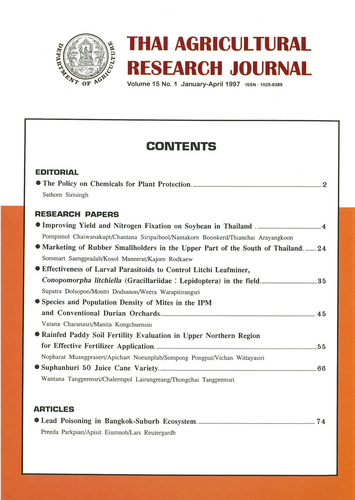Species and Population Density of Mites in the IPM and Conventional Durian Orchards
DOI:
https://doi.org/10.14456/thaidoa-agres.1997.4Abstract
Ecological monitoring on the impacts of pesticides and plant protection strategies to the abundance and diversity of mites in the IPM and conventional durian orchards was carried out during January to December 1994 in Rayong. Mite specimens were collected at four-week intervals both on durian trees and on the weeds. Specimens on the trees were obtained by collecting 20 durian leaves from four quadrants of each tree. Sixteen trees with the installation of sprinkler on the top were selected from the IPM orchard while the other sixteen were randomly selected from the conventional for leaf sampling. Specimens on the weeds were collected within ten sites of one square meter each by using vacuum sucking machine.rnResults from the investigation of mite specimens revealed the occurrences of three species of mite pests on durian both in the IPM and conventional orchards. The most important species was Eutetranychus africanus (Tucker). Their population was slightly more abundant in the conventional orchard. At least additional five and six species of predatory mites were found on durian trees in the IPM and conventional orchards respectively. The most important and dominant species was Amblyseius largoensis (Muma). Their population was slightly more abundant in the IPM orchard.rnMost of predatory mites obtained from the weeds collected by vacuum sucking machine were of no value for biological control of pests on durian trees. They were mostly soil inhabiting species. Most of the mites inhabiting weeds were not caught by the machine. However many specimens of A. largoensis, the most abundant species presents on the tree, was also found on the weeds.rnThe predator -prey relationship between E. africanus and phytoseiid predators could not be distinctly observed due to their low incidences in durian orchards. However, less harmful pesticides applied and the improvement of habitat quality for beneficials proved to increase some natural phytoseiids in the IPM orchard.
Downloads
Published
How to Cite
Issue
Section
License

This work is licensed under a Creative Commons Attribution-NonCommercial-NoDerivatives 4.0 International License.
Thai Agricultural Research Journal



